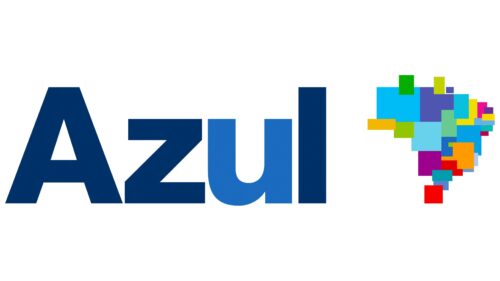 Azul Brazilian Airlines Logo PNG
Azul Brazilian Airlines Logo PNG
The Azul Brazilian Airlines logo captures the unity of opposites and the vibrant national identity of Brazil. The emblem reflects a deep and affectionate commitment to the homeland. It highlights that the company serves all residents of the country and can connect with everyone.
Azul Brazilian Airlines: Brand overview
One of Brazil’s biggest airlines, Azul Brazilian Airlines, was established in 2008. An opportunity to launch a new airline in Brazil was seen by Brazilian-American David Neeleman, an accomplished aviation executive and entrepreneur who had previously headed the profitable low-cost carrier JetBlue Airways in the US. His objective was to connect many of the nation’s communities that did not previously have direct air connectivity and to provide excellent service at reasonable costs.
On December 15, 2008, the airline launched its inaugural flight between Campinas and Salvador, marking the start of its operations. At the time, the airline’s fleet had three contemporary Embraer 195 aircraft outfitted to improve passenger comfort.
The name “Azul,” which translates as “blue” in Portuguese, represents Brazil’s wide blue skies and endless travel options. Blue is linked to dependability, trust, and superior service—values the company prioritized in all business operations.
The airline quickly expanded its route network in its first year of operation by adding new destinations and boosting flight frequencies. By the end of 2009, with a fleet of 14 Embraer aircraft, the airline was flying to 14 destinations in Brazil.
One of the main contributors to the airline’s success was its creative business strategy, which focused on using regional jets to run direct flights between cities while avoiding big hub airports. Eliminating the need for protracted layovers and connections allowed the airline to provide customers with more practical and convenient travel options.
In 2012, the airline began service to the United States, mostly to Florida, marking its entry into the global market. This action solidified the airline’s position as the dominant force in the area and started its journey outside of Brazil.
The company continued its fast development and network expansion in the following years. Following the acquisition of TRIP Linhas Aéreas in 2015, the airline became the second-largest carrier in Brazil based on passenger volume and a major boost to its domestic market presence.
Following a prosperous initial public offering (IPO) in 2017, the airline expanded and strengthened its position in the Brazilian and Latin American aviation sectors.
In 2018, the airline started flying to Galeão, the new international airport in Rio de Janeiro, increasing its footprint in one of Brazil’s biggest and most significant cities. By making this change, the company was able to give customers more practical travel choices and connections, which increased its marketability.
The newest and most effective model in the Brazilian manufacturer’s fleet, the Embraer E195-E2, was the subject of a significant order that the company announced that same year. This order confirmed the airline’s long-term cooperation with Embraer and represented a major turning point in the refurbishment and renewal of its fleet.
By adding additional routes to Uruguay and Argentina in 2019, the airline kept growing its network of foreign routes. The airline increased its market share in the cargo sector by utilizing Boeing 737-400F aircraft to operate regular cargo flights between Brazil and the US.
Before the worldwide pandemic hit in early 2020, the company upgraded its aircraft cabin with new seats, an entertainment system, and other design elements. With this modification, the airline hoped to emphasize its premium service level while improving passenger comfort and happiness.
Despite the difficult circumstances the epidemic brought about for the sector in 2021, the airline could still grow and hold the top spot on the market. As it adjusted to the new circumstances and safety regulations, the airline progressively increased the number of its flights.
The same year, the company made history by being the first airline in Brazil and among the first worldwide to be awarded the top 7-star safety rating by the esteemed international airline Airline Ratings. This rating attests to the airline’s extraordinary operational excellence, safety, and dependability standards.
In 2022, the company concentrated on increasing operational effectiveness, enhancing its route network, and increasing flying volumes. To improve the caliber of its customer service, the airline carefully considered integrating cutting-edge technologies, including digital platforms, mobile applications, and biometric passenger identification.
Meaning and History
What is Azul Brazilian Airlines?
It is a Brazilian low-cost air carrier based in São Paulo. It operates an extensive network of domestic flights and is developing international routes. Known for its service and modern fleet, it connects major cities and regional destinations throughout Brazil and international destinations in the Americas and Europe. The airline offers various classes of service, including economy and business class, focusing on customer comfort and satisfaction.
2008 – 2013
Azul Brazilian Airlines, founded in 2008, quickly became a prominent player in Brazil’s airline market. The company’s emblem reflects bright and key aspects of its identity. The company name “Azul,” which means “blue” in Portuguese, is rendered in blue. This shade is one of the colors of the Brazilian national flag and is widely used in the country as a symbol of calm, reliability, and trust.
The choice of the name “Azul” was intentional. The word is short, resonant, and memorable, which was a decisive factor in the naming contest for the new airline. The success of this option highlights the importance of the brand creating a name that is simple yet deeply symbolic and easily associated with its services and roots.
The logo design includes a map of Brazil’s administrative territories, located to the right of the company name. This element is adorned with bright-colored squares and rectangles that symbolize the cultural and ethnic diversity of Brazil’s population. Each color and shape on the map draws attention to the country’s cultural and social features and emphasizes the extensive geographic coverage of the company’s services nationwide.
2013 – today
The Azul Brazilian Airlines logo features only the first word of the brand name, “Azul,” written in large blue letters. Specifically, the letters “A,” “Z,” and “L” are in a darker shade of blue, while the letter “U” is in a lighter shade. Next to the text are numerous brightly colored polygons. These graphics are arranged in a patchwork style, consisting of many small, multicolored geometric shapes superimposed on each other. While the design may seem chaotic at first glance, it forms the shape of Brazil, the airline’s country of origin.
The patchwork design highlights the diversity and vibrancy of Brazilian culture. Using different shades of blue for the letters in the brand name adds visual interest and symbolizes the versatility and breadth of the airline’s services. The juxtaposition of multicolored geometric shapes represents the various destinations served by the airline, each unique but collectively forming a cohesive image of Brazil.
The airline’s patchwork style emphasizes cultural diversity and reflects its dynamic and inclusive approach. The colorful polygons create a vibrant mosaic that captures the essence of Brazil’s rich heritage and lively spirit.
Using different shades of blue for the letters gives the logo depth and dimension, making it more engaging and memorable. This color variation also conveys the idea of variety and adaptability, key attributes of a modern airline.
The multicolored geometric shapes, while individually distinct, come together to form a recognizable outline of Brazil. This clever design choice reinforces the airline’s strong connection to its home country and commitment to serving various destinations within Brazil.
The logo, with its large blue letters, patchwork of colorful polygons, and shape of Brazil, effectively communicates the airline’s diversity, vibrancy, and national pride.
FAQ
Is Azul the flag carrier of Brazil?
It is not Brazil’s flag carrier. This title was held by LATAM Airlines Brazil, known as TAM Linhas Aéreas, until its merger with LAN in 2012 to form the LATAM Airlines Group. As the national airline, LATAM plays an important role in Brazil’s international negotiations overflying rights. Despite its large domestic and international network, the company does not have flag carrier status. In 2020, TripAdvisor named it the World’s Best Airline, highlighting its significant influence and reputation in the global airline industry.





